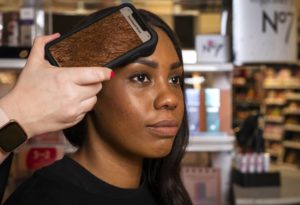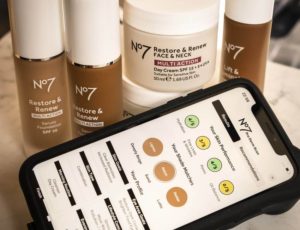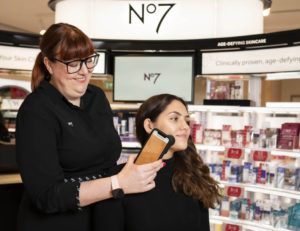Walgreens Boots Alliance has a 170-year heritage and employs over 325,000 people across nine countries. At this scale, innovation is a challenge. So, when the changing marketing landscape is calling for exceptional customer experience, how does marketing innovation occur? The answer for Walgreens Boots Alliance is a digital incubator under its No7 Beauty Company division: The Beauty Incubator.
Targeting lifelong relationships with its customers, The Beauty Incubator created The Pro Derm Scan service, which assists customers with identifying the right skincare products for their skin. This digital incubator has transformed customers’ approach to skin health and skin longevity.
Exceptional customer experience, delivered through agile innovation, improved online skincare advisor customer conversions by 3.6 times and increased average order value by 48%. We spoke to Munnawar Chishty, Global Vice President and Marketing Director of Beauty, Walgreens Boots Alliance, to find out how the No 7 Beauty Company digital incubator has created such an exceptional personalized customer experience.
Step 1: Begin with customer insights

In the last two years, consumer behavior has changed. They expect a far more personalized approach from brands. This is particularly pertinent for skincare, where customers looking to boost their skin health should make sure the products, they consume are correct for their skin type.
The response from brands such as Walgreens Boots Alliance and the No7 Beauty Company has been to focus on lifelong customer value.
“If you increase your lifetime value, then the business trajectory moves in the right direction. It’s not just a penetration game, it’s about the value that each customer brings. In, particularly in our industry, consumers aren’t just buying one product, they are buying multiple products for their total beauty regime. There is a lot of opportunity for us to build an in-depth relationship with customers.”
Accordingly, this digital incubator is building lifetime value by providing disruptive, personalized experiences. The first step of such innovation is understanding the problem you are trying to solve. This begins with the customer.
“Start with the consumer to understand the problems that you’re looking to solve. We did that through several workshops. We identified our core consumers, examined their consumer experience journeys, and looked for friction points.”
“At the beginning of the customer journey, we found their biggest issue was that they didn’t understand their skin issues. So, it’s hard for them to truly identify the right products to use. So that’s a real friction point for them. We also identified other friction points throughout the journey, but that was the first one that we decided to tackle because that was the one that consumers were looking for at the start of their journey.”
Validate your data
To validate these findings, The Beauty Incubator also examined google searches. It found a vast number of consumers searching questions such as ‘What is my skin type?’ and ‘What is the skin issue that I’m having?’
It also validated these findings through customer research and studying No7 Beauty Company’s first-party data. This confirmed a clear problem to solve and set a North Star for The Beauty Incubator.
Step 2: Digital incubator best-practices

Corporations the size of Walgreens Boots Alliance benefit from rigorous processes, systems, and governance that enable the business to function. But these can limit the ability to be agile with innovation and to implement an incubator-style test and learn approach.
To circumvent these challenges, The Beauty Incubator had to identify the correct internal change agents and external partners, work within a tight budget, and deliver quick wins that proved the use case for a digital incubator.
Digital incubator team structure
Chishty communicated her vision for the digital incubator with key stakeholders across departments such as R&D, IT, Insights, and finance. She formed a small scrum team to operate at no extra resource to the business.
“Firstly, I knew all the skill sets that I needed to set up an incubator. I needed someone from IT that understood technology and CX journeys, someone from R&D that understood skin concerns and science, and someone from finance that understood how to build business cases Secondly, I looked for people within the business who would thrive in a change agent program. You must have the right personality to want to work on something agile.”
Having identified the right talent, Chishty established an organizational structure conducive to success with an agile incubator environment.
“In The Beauty Incubator, it’s a core scrum group that works together. There’s no hierarchy on it. I chair it, but we work together, and we make calls together. That’s why you need people with the right mindset to take responsibility and accountability for those decisions together with the team.”
Indeed, the responsibilities of the team working for the digital incubator sat on top of their day-to-day roles. Moreover, the challenges didn’t stop with finding the right team.
Innovation on a budget
The reality for The Beauty Incubator was that it would need to prove its use before receiving any substantial funding. From headcount to budget, Chishty had to work with the existing resources she had.
“Without a business case that proved our work was effective, it would just be assumptions and hypotheses. We wanted to do something much more disruptive and longer term. But to do that with no resources you have to think smartly about what you can deliver and prove the value of the incubator early on, to unlock future investment.”
“Having identified the problems we wanted to solve, we had to think creatively about how to solve them. We weren’t going to have the funding to go and create a million-pound app or a new diagnostic system. With an incubator, you don’t have to reinvent the wheel. It’s about marrying your solution with the problem. And that solution doesn’t have to be overly complex.”
If building a solution was impossible, The Beauty Incubator would have to turn to an existing solution within the market. This meant reaching out to potential external partners who had already built a product but wanted to run it at scale.
“We identified some existing agency partners that could connect us with the right startups. We put problems out into the marketplace, and if any business felt their technology could solve it, we met with them to discuss their proposal.”
“If it looked promising, we’d run a low-cost agile sprint to truly understand if the technology was something we could use to deliver value to our customers and monetize accordingly.”
This eventually led The Beauty Incubator to Revieve, an AI-based diagnostic technology partner whom they worked with on an eight-week trial, based on a test-and-learn approach.
Test-and-learn is the digital incubator ethos
Here the product was developed, tested, and constantly iterated. This was done with the help of consumers live testing the product. This highlighted several points of optimizations where customers were dropping off in the personalization journey.
“We saw a massive drop off during one of the sprints when users were taking selfies that the service would use to identify their skin type. A closer look showed us there were a lot of camera errors coming up, so we fixed that.”
“Moreover, we had a drop-off at the recommendation stage. We were recommending twelve products to the users. They didn’t know which to buy, and there was a huge drop-off in conversion rates. So, we got it down to three product recommendations, and conversion rates shot up.”
A core lesson from this process was to focus on simple solutions. The Beauty Incubator even tested more complex solutions such as genetic testing machines, before considering that it would be better to focus on a better experience on our existing platforms. But, as Chishty states, “overthinking is a part of testing and learning.”
Beyond product iteration, The digital incubator also learned and matured its approach to collaborating with external partners, due to an agency partnership that failed to deliver its promises. Although agile and quick work is imperative, thorough due diligence of external partners is not something an incubator can forgo.
Step 3: Secure and communicate quick wins

Self-governance allowed The Beauty Incubator to be agile and move freely with its test-and-learn approach. It also meant the team took responsibility for monitoring and measuring the performance of the personalized service across a wide range of metrics. This was vital to both improve the quality of the Pro Derm Scan service and to prove its value to drive further investment.
“Metrics covered a range of key areas such as revenue, basket size, and conversion rates but we also centered some of the metrics on customer and advisor experience and satisfaction. It was important to understand their experience of the service. Did it offer a point of difference and elevate the brand experience?”
As highlighted above, measuring conversion rates and tracking customer experiences allowed The Beauty Incubator to learn where customers were dropping off, and fix the issues in the service. Beyond customer experience, it also considered the experience of its team of beauty advisors and their perspective on the service.
“Did the customers find it easy? How many steps do they have to go through? How quick was it? Was the interface easy? Afterward, do they come back? Do they rebook an appointment?”
This helped the digital incubator begin to see the impact of the Pro Derm Scan service on the potential lifetime value of its customers.
Measuring holistically
Lastly, it covered financial metrics, including trial rates, conversion rates, and average order value, and measured this against the performance of control stores. The new service improved revenue, cross-category sales, and basket size as well as return bookings and increased consumer and advisor satisfaction. The incubator saw similar strong results from its online skincare advisors. Customer conversions increased by 3.6 times and average order value increased by 48%.
“The point is that you can’t just look at one set of business metrics. You’ve got to look at it holistically around the consumer experience. Once the initial experience has happened, how did the consumer behave afterward?”
Driving further investment
Having improved conversion rates and average order value, The Beauty Incubator had a use case. It had proved this personalized service was adding value. This was the fuel Chishty needed to secure further investment.
“We could then engage with the business around a conversation around further investment. We showed them what we’d been able to do with little to no budget and presented the vision we could build with more investment. Off the back of that, we unlocked headcount and proper investment.”
By focusing on what it could deliver most quickly and easily, at a low cost, The Beauty Incubator has since been able to launch more disruptive programs.
What’s next for the digital incubator?
Whilst such programs are still under development, and therefore under close wraps, The Beauty Incubator now has a clear North Star for future projects.
“Data-driven, omnichannel, personalized experiences. These are the three things that must come together.”
As the Walgreen Boots Alliance continues its path to building customer lifetime value, The Beauty Incubator will help transform first-party data insights into powerful customer experiences. Whilst it may benefit from more funding and resources in the future, its agile methodology and focus on innovation will remain at its core.
Subscribe to the ClickZ newsletter for insights on the evolving marketing landscape, performance marketing, customer experience, thought leadership, videos, podcasts, and more.
The ClickZ Marketing Masters Podcast Season 2 is now live! Tune in wherever you get your podcasts, including Apple, Spotify, Google, and Amazon. Don’t forget to subscribe!
The post How a Walgreens Boots Alliance digital incubator is innovating personalized customer experiences appeared first on ClickZ.
from ClickZ https://ift.tt/RHoCgA1
via IFTTT
Comments
Post a Comment